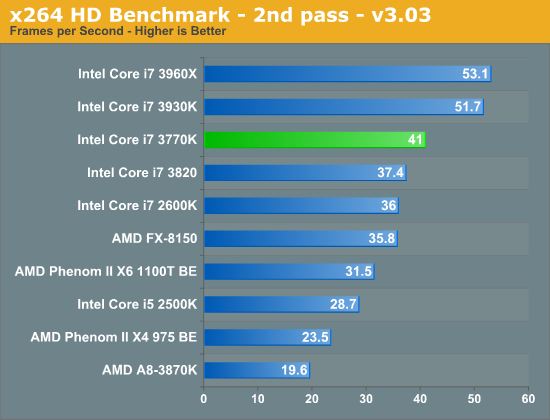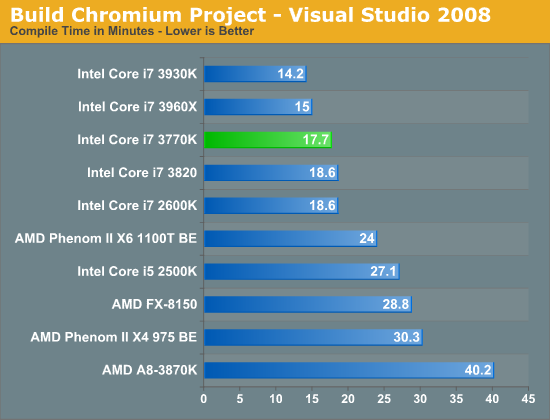The Ivy Bridge Preview: Core i7 3770K Tested
by Anand Lal Shimpi on March 6, 2012 8:16 PM EST- Posted in
- CPUs
- Intel
- Core i7
- Ivy Bridge
Video Transcoding Performance
x264 HD 3.03 Benchmark
Graysky's x264 HD test uses x264 to encode a 4Mbps 720p MPEG-2 source. The focus here is on quality rather than speed, thus the benchmark uses a 2-pass encode and reports the average frame rate in each pass.


In the second pass of our x264 test we see a nearly 14% increase over the 2600K. Once again, there's no replacement for more cores in these types of workloads but delivering better performance in a lower TDP than last year's quad-core is great for more thermally conscious desktops.
Software Development Performance
Compile Chromium Test
You guys asked for it and finally I have something I feel is a good software build test. Using Visual Studio 2008 I'm compiling Chromium. It's a pretty huge project that takes over forty minutes to compile from the command line on a Core i3 2100. But the results are repeatable and the compile process will stress all 12 threads at 100% for almost the entire time on a 980X so it works for me.

Ivy Bridge shows more traditional gains in our VS2008 benchmark - performance moves forward here by a few percent, but nothing significant. We are seeing a bit of a compressed dynamic range here for this particular compiler workload, it's quite possible that other bottlenecks are beginning to creep in as we get even faster microarchitectures.










195 Comments
View All Comments
niva - Wednesday, March 7, 2012 - link
I think it's a long time away from approaching 560m performance. If you're going to do any remotely serious gaming on a laptop it's still best to get a dedicated graphics card.I'm still sticking to gaming on a tower, so these CPUs (esp the AMD llano) make sense for me in laptops. Don't ever see myself gaming on a laptop unless I completely get rid of the towers in my house... which won't happen anytime soon (if ever.)
pepperoni - Wednesday, March 7, 2012 - link
I felt the same way when I was shopping recently. I WANTED to buy a Llano-based notebook (inexpensive, better graphics vs. Intel). The problem is there's no such thing as a slim and light Llano. Every OEM sticks you with the same configuration: six pounds and 15.6" turd-768 resolution screen. It's bizarre.For the sake of competition, I hope Trinity will get some better design wins.
CeriseCogburn - Sunday, January 27, 2013 - link
If you look at the gaming charts, the resolution may go past x768, but the settings are on LOW, and don't give us a minimum frame rate, so the answer is:That's all that llano can handle is low end low rez.
So AMD forces the giant .lb weighted monster as a selling point.
poached - Wednesday, April 18, 2012 - link
so AMD?Demon-Xanth - Wednesday, March 7, 2012 - link
I agree with you there. To get those "$100 mid range GPUs" on a laptop you need to bump up the cost by around $400 to get to one that simply can have one. Most laptops currently do not have discrete GPUs.I am glad to see that integrated graphics from both Intel and AMD can now be compared with low end cards like the GT520 and GT440 without it becoming a laugh. Also that they are actually completing the tests well now. That is a rather major step. I remember some reviews of integrated graphics that resulted in a lot of either "could not complete" or "the bar is too small to fit a number on" entries.
Azethoth - Wednesday, March 7, 2012 - link
The IGP provides the QuickSync implementation. It would be insane to not include the silicon for it on the high end system. In addition moving forward you can get compute work out of the GPU so why would you ever not include it.danjw - Wednesday, March 7, 2012 - link
Quicksync the Intel video transcoding feature is based in the GPU. This is important to a lot of users.sweetspot - Wednesday, March 7, 2012 - link
Well also these make for nice office machines. So businesses upgrading there desktop workstations.When you have thousands of employees, the desktop refresh, these are decent option, since they are not gaming at work ( right lol ).
Taft12 - Sunday, March 18, 2012 - link
Hardly any large corporations buy desktops anymore. Maybe for the call centre employees, that's about it.AFUMCBill - Wednesday, March 7, 2012 - link
Because gaming isn't the only thing that uses graphics cards. For instance, more and more video editors use the graphics card for doing video decode/encode/applying effects. So having a high performance graphics engine to go along with the high performance CPU can be a really nice thing.